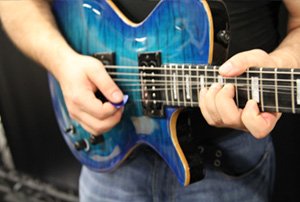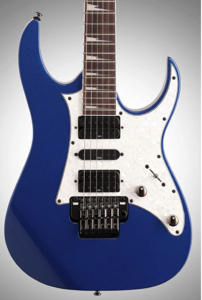The guitar anatomy defines a versatile and beloved musical instrument that has captured the hearts of millions of musicians and music enthusiasts around the world.
 Whether you’re a beginner picking up a guitar for the first time or a seasoned player looking to deepen your knowledge, understanding the anatomy of the guitar is crucial for both playing and maintenance. In this article, we will explore the different parts of a guitar and their functions, giving you a comprehensive understanding of this remarkable instrument.
Whether you’re a beginner picking up a guitar for the first time or a seasoned player looking to deepen your knowledge, understanding the anatomy of the guitar is crucial for both playing and maintenance. In this article, we will explore the different parts of a guitar and their functions, giving you a comprehensive understanding of this remarkable instrument.
1. Headstock: Located at the top of the guitar, the headstock houses the tuning pegs or machine heads. These pegs are used to adjust the tension of the strings, enabling you to tune the guitar to the desired pitch. The headstock design can vary depending on the guitar brand and model, and it often features the manufacturer’s logo.
The headstock is a vital and distinctive part of a guitar, located at the top of the instrument where the strings are anchored and tuned. It plays a significant role in both the functionality and aesthetics of the guitar. Let’s explore the headstock in more detail:
- 1. Tuning Pegs/Machine Heads: The primary purpose of the headstock is to house the tuning pegs or machine heads. These are mechanical devices that allow you to adjust the tension of each string, thereby changing its pitch and enabling you to tune the guitar to the desired notes. Turning the tuning pegs clockwise tightens the string, raising the pitch, while turning them counterclockwise loosens the string, lowering the pitch.
- 2. String Retainers: Some headstocks feature string retainers, which are small metal or plastic bars or rollers positioned near the nut. Their purpose is to guide the strings to maintain proper tension over the nut, reducing friction and ensuring smooth tuning stability.
- 3. String Trees: On certain headstock designs, especially those with angled back headstocks, you may find string trees. These are small guides that help keep the strings aligned and maintain their tension. String trees are particularly common on guitars with Fender-style headstocks.
- 4. Brand Logo: The headstock often displays the manufacturer’s logo or brand name. This logo can be inlaid, painted, or printed on the headstock face. The brand logo is not only a visual identifier but also a representation of the guitar’s heritage and quality.
- 5. Truss Rod Cover: On guitars with adjustable truss rods (used to adjust the neck’s curvature), there is typically a truss rod cover on the headstock. This cover can be removed to access the truss rod for neck adjustments.
- 6. Design and Shape: Headstocks come in various shapes and designs, and different guitar manufacturers have their signature headstock styles. Some popular designs include the Fender Stratocaster and Telecaster headstocks, Gibson’s open-book headstock, and PRS’s unique design. The headstock’s shape can also influence the guitar’s overall balance and aesthetics.
- 7. Reinforcement: The headstock is subject to significant tension from the strings, making it susceptible to fractures or breaks. To reinforce the headstock’s strength, many guitars have an angled design, where the headstock extends back from the neck at a slight angle. This angled design helps distribute the string tension along the headstock and reduces the risk of damage.
Guitar Wireless System: Unleashing Freedom
The 8-String Guitar: Expanding Your Possibilities
Fender Deluxe Telecaster: A Timeless Guitar
Classical Guitar vs Acoustic: Understanding the Differences
Mooer PE100: A Compact Multi-Effects Pedal for Guitarists
2. Nut: The nut is a part of the guitar anatomy that is a small, usually ivory or plastic, piece that sits between the headstock and the fretboard. It has narrow grooves that hold the strings in place, maintaining the correct spacing and height from the fretboard.
3. Neck: The neck is the long, narrow part of the guitar that extends from the body. It is usually made of wood, and its back shape can vary from thin and flat to thick and rounded, depending on the guitar’s design. The fretboard is attached to the top of the neck, and the strings run along it.
The neck of a guitar is a fundamental and crucial component that directly impacts how the instrument feels and plays. It is the elongated, slender part of the guitar that extends from the body, holding the fretboard and providing the platform for the strings. The neck plays a significant role in determining the guitar’s playability, tonal characteristics, and overall comfort for the player. Let’s explore the various aspects of the guitar neck:
- 1. Neck Wood: Guitar necks are typically made from various types of wood, each with its unique characteristics. Common woods used for neck construction include maple, mahogany, rosewood, and ebony. Maple necks are known for their bright and snappy tones, while mahogany necks tend to produce warmer and more balanced tones. The choice of wood can significantly influence the guitar’s overall sound.
- 2. Neck Shape/Profile: The neck shape, also known as the neck profile, refers to the contour and thickness of the back of the neck. Guitar necks can have different profiles, such as C-shaped, U-shaped, V-shaped, or modern slim profiles. The profile affects how the neck fits in the player’s hand, and different players may have preferences for specific neck shapes based on comfort and playing style.
- 3. Fretboard/Fingerboard: The fretboard, also called the fingerboard, is a flat, smooth surface that sits on top of the neck. It is typically made from materials like rosewood, ebony, or maple. The fretboard contains metal frets that divide the neck into specific intervals, allowing the player to produce different pitches when pressing down the strings. Different fretboard materials can influence the guitar’s tone and feel.
- 4. Fret Markers: Fret markers are small, often dot-shaped inlays or other designs on the fretboard. They serve as visual guides to help the player navigate the fretboard and find specific notes. Common locations for fret markers include the third, fifth, seventh, ninth, twelfth, fifteenth, and seventeenth frets.
- 5. Scale Length: The scale length is the distance between the nut and the bridge, determining the vibrating length of the strings. Guitars typically have scale lengths ranging from 24.75 inches (found on Gibson-style guitars) to 25.5 inches (common on Fender-style guitars). The scale length affects string tension, playability, and tone.
- 6. Neck Joint: The neck joint is the point where the neck is attached to the guitar body. There are various types of neck joints, such as bolt-on, set-neck, and neck-through. Each type has its advantages in terms of sustain, stability, and ease of repair.
4. Fretboard: Also known as the fingerboard, the fretboard is a flat, smooth surface made of wood, often rosewood or maple. It contains metal frets, thin strips embedded into the wood at specific intervals, which divide the strings into different pitches when pressed down by the fingers.
5. Frets: Frets are the metal bars that cross the fretboard. Pressing a string against a fret shortens its vibrating length, raising the pitch of the note produced when the string is plucked.
6. Body: The body is the largest part of the guitar and provides resonance and tone. It can be made from various materials, such as solid wood, laminate, or composite materials. The shape and size of the body can greatly influence the guitar’s sound and playability.
7. Pickguard: The pickguard is a protective plate, usually made of plastic or other materials, that is placed below the strings and around the soundhole. Its purpose is to prevent scratches or damage caused by the use of a pick or fingernails.
8. Soundhole: On acoustic guitars, the soundhole is a round opening in the body through which sound is projected. The vibrations of the strings resonate within the body, and the sound is amplified and projected out through the soundhole.
9. Bridge: The bridge is a component located on the body of the guitar, near the soundhole. It holds the strings in place at the other end of the instrument from the nut and transfers the vibrations to the body, contributing to the guitar’s overall sound.
10. Pickups: Pickups are electronic devices located on electric guitars. They capture the vibrations of the strings and convert them into electrical signals that can be amplified and heard through an amplifier. There are different types of pickups, including single-coil and humbucker pickups, each with its own unique sound characteristics.
Understanding the anatomy of the guitar is not only essential for playing, but it also enables you to communicate effectively with other musicians and guitar technicians.

